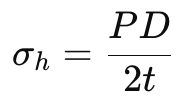Pressure Vessel Thickness Calculator
Pressure Vessel Thickness Calculator
Wiratama
11/16/20251 min read
1. Definition
A Pressure Vessel Thickness Calculator determines the minimum required wall thickness of a cylindrical pressure vessel subjected to internal pressure. The calculation follows the classical thin-wall formulation used in ASME Section VIII Division 1 for preliminary design.
It considers internal pressure, vessel diameter, allowable stress, and weld joint efficiency.
2. Background Theory
Pressure vessels operate under internal pressure, which generates circumferential (hoop) stress. For a cylindrical vessel, the primary stress is:


Where:
P = internal pressure
D = internal diameter
t = wall thickness
ASME uses a rearranged form to compute required thickness:
ASME Section VIII Div. 1 (Thin-Wall) Formula:


Where:
S = allowable stress of the material
E = weld efficiency (0.6–1.0 depending on radiography)
This formula applies to internal pressure for a cylindrical shell and is widely used in pressure vessel manufacturing, refinery equipment, boilers, reactors, and storage vessels.
3. How the Calculator Works
The calculator performs four engineering steps:
Step 1 — User Inputs
Internal pressure (MPa)
Vessel internal diameter (mm)
Allowable stress (MPa)
Weld joint efficiency (0–1)
Step 2 — Converts units (if needed)
MPa is directly compatible with N/mm², so the formula uses consistent units.
Step 3 — Computes required thickness
Using the ASME-like thin-wall formula.
Step 4 — Displays result
Required shell thickness (mm)
Based on internal pressure loading
Suitable for preliminary sizing
This calculator gives a first-pass engineering estimate, typically followed by:
corrosion allowance
fabrication tolerance
code checks (UG-16, UG-27)
fatigue analysis (if needed)
